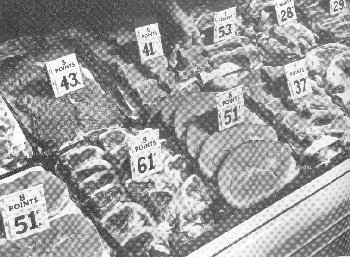One
of the major efforts needed during the war was homefront
conservation. Since so much production was needed for the
war effort, conservation on the homefront let everyone concentrate
more on the war instead of producing extra for the home.
Urgent requirements for war materials caused many shortages
in consumer goods. In the U.S., rationed items included
meats, butter, sugar, fats, oils, coffee, canned foods,
shoes and gasoline.
The
U.S. had vast resources on such basic materials as chemicals,
coal, copper, cotton, iron, lead, nitrates, petroleum
and wool but lacked raw materials such as quinine, rubber,
silk and tin, aluminum, cork, graphite, optical glass
and platinum.
Patriotic
citizens began ransacking their attics for every type
of scrap. Groups and clubs began all types of 'drives'.
For example, the Boy Scouts salvaged so much waste paper
(over 150,000 tons) by 1942, that paper mills were glutted
and had to temporarily call off the paper drive.
U.S.
citizens were not used to making any type of sacrifice,
so rationing came as a shock. Suddenly there were all
types of little books and stamps that limited gas or certain
types of food. Plus unending posters of 'instructions'.
Gas
rationing was the most unpopular. The average driver received
an 'A' card that limited him to 3 gallons of gas a WEEK.
Food
was rationed by a point system that drove housewives and
grocers crazy.

Poster Index


